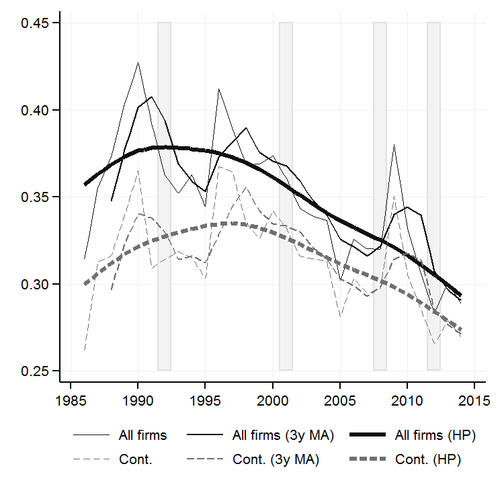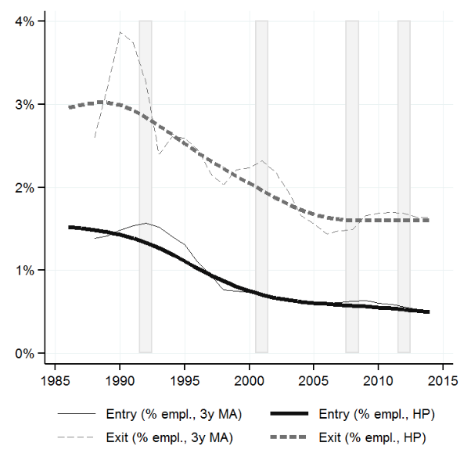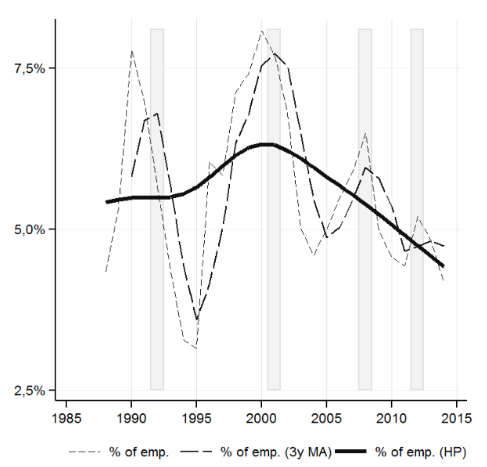During his 2005 commencement speech at Stanford University, Steve Jobs famously said that death is very likely the single best invention of life, as it clears out the old and makes way for the new. Business dynamism, or the fact that new firms arise, die, expand, and contract, is generally considered to play a key role for aggregate productivity growth. Using US establishment data, Davis and Haltiwanger (1991) were the first to document such a process of creative destruction, triggering a new stream of research documenting business dynamism for other countries (Haltiwanger et al. 2014). This research showed how old, sluggish firms make way for newer, more innovative, and more productive firms. It also shows how a high level of business dynamism implies that resources can easily be reallocated from low-productivity to high-productivity activities in the economy.
While it has been well documented that the level of business dynamism varies across countries, usually due to different levels of labour and product market regulation, little is known about its evolution over a long period of time that spans various business cycles. Recent work by Decker et al. (2016) shows that, for the US, business dynamism has been declining over the past decades and that the nature of the decline changed around 2000, with a decline in (young) high-growth firms. High-growth firms are firms that have experienced an annualised growth greater than 20% over a three-year period, with at least 10 employees at the start of the growth period. Typically, young high-growth firms invest more in innovation than other firms and are thus responsible for a disproportionate share of employment and productivity growth (e.g. Acemoglu et al.2017, Haltiwanger et al.2016). High-growth firm activity is therefore often seen as a good proxy for the level of entrepreneurship in an economy.
While the decline in business dynamism has been well documented for the US, there is no work using the decades of data available for other countries. In a recent paper, we fill this gap by studying the business dynamism of Belgium’s small, open economy using 30 years of data from 1985 to 2014 (Bijnens and Konings 2018). We find a similar decline in business dynamism as in the US, which also sets in around 2000. This is remarkable as firms in the US face a far less rigid institutional environment than the ones located in Belgium.
The same secular decline in business dynamism in a small, open, European economy as in the US
In our paper we use various measures to study business dynamism. Predominantly, we based our analysis on the statistical distribution of firm employment growth rates and their evolution. In particular, we calculated the dispersion of the distribution as the difference in growth rate between a firm at the 90th and a firm at the 10th percentile of the distribution, also referred to as the 90-10 differential. The higher the dispersion, the more reallocation between firms. A second measure looks at the entry and exit of firms, which is a good indicator of creative destruction in an economy. A third indicator looks at high-growth firm activity.
Figure 1 90-10 differentials for all firms and continuing firms only
Note: Grey shaded areas mark recessions; ‘cont.’ abbreviates for ‘continuing firms’; ‘MA’ ‘moving average’ and ‘HP’ ‘Hodrick–Prescott filtered’. See details in Bijnens & Konings (2018).
Figures 1 to 3 illustrate the pervasive decline in business dynamism in Belgium since 2000. Figure 1 shows the dispersion (90-10 differential) for both all firms and continuing firms only, in which the group of continuing firms excludes entering and exiting firms. We see a decline for both measures, suggesting that the overall dynamism decline is not solely driven by reduced start-up activity. Figure 2 zooms in on firm entry and exit. Also here we see a secular decline over the past decades. Figure 3 shows the employment at high-growth firms. We observe a clear trend change around 2000, after which there is a pronounced decline of high-growth firm activity.
Figure 2 Relative firm entry and exit rates
Note: Employment at firms entering/exiting as percentage of total employment. See details in Bijnens & Konings (2018).
Figure 3 Relative employment at high-growth firms as a percentage of total employment
Note: High-growth firm activity goes up before 2000 and comes down in the new millennium.
The empirical findings in Figures 1 to 3 show a clear decline in business dynamism, setting in around the year 2000. A substantial part (approximately one third) is driven by lower start-up rates, shifting employment towards older, less dynamic firms. An additional driver is the decline of employment at high-growth firms.
The role of information and communication technology
We see surprising similarities between our findings for Belgium and those from Decker et al. (2016) for the US. This is remarkable as the US economy, being large and mainly self-reliant with low but increasing regulation, is very different from the Belgian economy – small and very open with high but decreasing regulation. This leads us to believe that global changes affecting all countries likely played a role in the secular decline in business dynamism, rather than country-specific changes. One of the possible global changes might be the increasing use of information and communication technology (ICT), a key enabler in the production process. Figure 4 shows the dispersion (90-10 differential) for firms in ICT-intensive versus non-ICT-intensive sectors. We classify industries based on the impact of ICT investments on value added.1 We argue that the industries with the highest contribution of ICT to value added are the ones that were most affected by the ICT revolution in the second half of the 1990s. Companies in these sectors who did not successfully invest in ICT, saw (compared to other industries) a disproportionate impact on their value-added growth and were hence more likely to stagnate or disappear. As acquiring ICT knowledge and infrastructure is, to a certain extent, a fixed cost, smaller companies were more likely to miss out on the ICT revolution. This could ultimately result in a loss in business dynamism as a limited number of successful companies became more dominant in an industry.
Figure 4 90-10 differential split by level of ICT intensity
Note: The dynamism increase before 2000, and decline after 2000, are predominantly driven by ICT-intensive industries.
As Figure 4 demonstrates, both ICT-intensive and non-intensive industries experience an initial uptick in dynamism linked with the increased start-up rate of the 2nd half of the 1980s. Subsequently the non-ICT-intensive industries experience a slow, continuous decline throughout the studied period. ICT intensive industries, however, show a strong increase in dynamism until the second half of the 1990s followed by an even stronger decrease. The overall pattern of change in dynamism in the late 1990s is predominantly driven by the ICT-intensive industries. The initial uptake of ICT caused increased reallocation from firms not investing in ICT to firms investing in ICT, which initially lead to an increase of business dynamism. The ICT-investing firms became larger and more productive and pushed the smaller, less productive firms out of the market. The surviving firms became the ‘superstar firms’ of their industries, potentially causing a subsequent decline in business dynamism.
Policy implications
We do not yet fully understand the causes or the economic implications of the recent decline in business dynamism, and the reduced role of high-growth firms. Recent evidence however, implies that this decline must remain a concern for policymakers, since it is likely part of the factors that explain the current productivity stagnation. The decline in business dynamism coincides with a period of low-interest rates and the emergence of ‘zombie firms’ – firms that only survive because of easy credit and that might constrain the process of creative destruction. Also in this period, we witness a rise in market power and ‘superstar’ firms who potentially benefit more from exploiting ICT and global value chains (De Loecker and Eeckhout 2018). Policies should therefore consider mechanisms which lift constraints to the process of reallocation of people, assets, and knowledge between firms, enhancing, transferring, and spreading the benefits from ICT and global value chains to young and innovative firms.
Authors’ note: The research is part of the ‘Econopolis Chair’ on Firm Growth and the KU Leuven Methusalem Research grant.
References
Acemoglu, D, U Akcigit, U, N Bloom and W R Kerr (2017), “Innovation, reallocation, and growth”, Becker Friedman Institute for Research in Economics, Working paper no 21.
Bijnens, G and J Konings (2018), “Declining business dynamism”, CEPR Discussion Paper 12615.
Davis, S and J Haltiwanger (1992), “Gross job creation, gross job destruction, and employment reallocation”, Quarterly Journal of Economics 107(3): 819–863.
Decker, R A, J Haltiwanger, R S Jarmin and J Miranda (2016), “Where has all the skewness gone? The decline in high-growth (young) firms in the US”, European Economic Review 86: 4–23.
De Loecker, J and J Eeckhout (2018), “Global market power”, CEPR Discussion Paper 13009.
Haltiwanger, J, R S Jarmin, R Kulick and J Miranda (2016), “High growth young firms: Contribution to job, output and productivity growth” US Census Bureau, Center for Economic Studies, Paper no CES-WP-16-49.
Haltiwanger, J, S Scarpetta and H Schweiger (2014), “Cross country differences in job reallocation: The role of industry, firm size and regulations”, Labour Economics 26: 11–25.
Moreno, F and A Coad (2015), “High-growth firms: Stylized facts and conflicting results”, in A Corbett, J Katz and A McKelvie (eds), Entrepreneurial growth: Individual, firm, & region: 187-230, Emerald Group Publishing Limited.
Mortensen and Pissarides (1994), “Job creation and job destruction in the theory of unemployment”, Review of Economic Studies 61: 397–415.
Endnotes
[1] See Bijnens & Konings (2018) for details of this classification.







